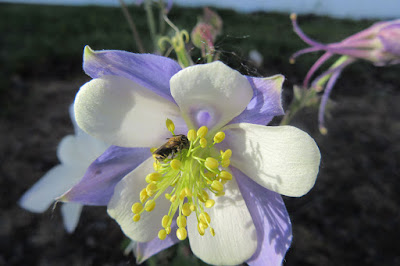Here in the United States, each state has a state flower. The state flowers are often showy species, chosen to represent the flora of the state. In Colorado, our state flower is the Rocky Mountain or Blue columbine (also known as the Colorado and Colorado blue columbine). The scientific name, which literally means ‘blue columbine’, is pronounced ak-will-EE-jee-uh sir-EW-lee-uh. We have several clumps of this pretty perennial blooming in Mother Nature’s Montrose Garden.
The genus Aquilegia contains 60-70 species of Columbines and is limited to the Northern Hemisphere. Along with the Delphiniums, Aconitum (Monkshood), Actaea (Baneberry) and Trollius (Globeflower), the Columbines are now placed in the Hellebore Family (Helleboraceae). They were formerly included in the Ranunculus Family, and are still placed there in some references.
Five columbine species are native to Western Colorado: Aquilegia saximontana (Dwarf columbine), A. micrantha, A. barnebyi, A. elegantula and A. coerulea. [1] The columbines, which are perennials, like a little extra spring water, so they are usually not found in very dry climates. They are mainly plants of woodlands, meadows and higher elevation plant communities. And they often grow in places with a little shade. In Colorado, Blue columbine can occur in sagebrush, pinyon-juniper, mountain-brush, aspen, Douglas fir, Aspen-tall forb, spruce-fir, and alpine tundra communities. It is common to see it growing among the aspen.
The columbines have characteristic, highly modified flowers with five elongated spurs. The Latin name (Aquilegia) comes from these spurs, which sometimes resemble eagles’ claws—aquila is Latin for “eagle.” [2] The flowers come in many colors, making them a popular garden perennial, even in places where they are not native.
Rocky Mountain columbine is a bushy, clumping perennial from a taproot. The leaves are mainly clustered at the base. The leaves are compound – somewhat reminiscent of Maidenhair fern or Meadowrue. Leaves are medium-green and emerge slightly before the flower stalks in the spring.
Flowers are especially attractive in this species of columbine. Plants bloom anytime from mid-spring to summer, and plants may bloom for a month or more. Flowers are borne on 1 ½ to 2 ft (0.5-0.7 m.) stalks, each containing 4 to as many as 10 or 12 flowers, opening over time. The flowers themselves are large: they can be up to 3” across, with spurs extending 2”.
Unlike some columbines, the flowers of Rocky Mountain columbine are erect (not nodding). And the colors are a gardener’s delight! The most common flowers have blue-violet petals and spurs, with a white cup and many bright yellow stamens. But the colors can range from entirely white or pale yellow, pale pink or lavender with white – even entirely blue. The photos above and below show some examples.
In addition to their beauty, the flowers are sweetly scented. They attract a variety of pollinators, including bees, butterflies and hummingbirds. In the early morning and evening, large hawkmoths can be seen nectaring and pollinating. In fact, the hawkmoths may be important pollinators in some gardens, along with bumble bees, other solitary bees and flower flies. The flowers can even provide a pleasant bed for a Long-horned bee (below).
Blue columbine is an easy perennial to grow, from USDA Zones 3-9, making it a popular choice for gardeners. It is not picky about soil texture, and can be growing in all but heavy, poorly-draining soils. It prefers some afternoon shade in hot gardens, but can be grown in full sun to light shade in many gardens. One thing it does need is fairly regular water – at least through mid-summer. When the foliage dies back, usually in summer, plants can be cut back to the ground, then covered with an appropriate mulch. You may even get a second blooming in fall.
Aquilegia coerulea is a short-lived perennial; in most situations, individual plants live 2-3 years. But plants produce abundant seeds, and may naturalize in the garden environment. To prolong blooming (and prevent self-seeding), dead-head flowers before seed-set. If you want to collect seeds, wait until the pods have dried on the stalk. Then break open the pods and collect the seeds. Seeds can be scattered out in the fall, or given a cold-moist treatment and planted in spring. If you start seeds in pots, be sure to plant out before the taproot gets too long.
One important point: all parts of the plant are poisonous. Be sure not to ingest any part of the plant. Also, the sap may cause skin irritation in some people. So it’s best to wear gloves when cutting the columbines.
Rocky Mountain columbine is a showy perennial for flower beds, natural gardens, cottage gardens, around shrubs and along walkways. It can even be grown in deep containers. It’s a classic garden plant, grown in many parts of the world. It brings attractive pollinators to the garden. And, if you live in Colorado, it’s your state flower.
Including a state flower in your garden is a great way to celebrate your pride of place. If enough gardeners plant the state flower, it can unify a neighborhood in a way unique to the locale. And if you like cut flowers, Blue columbine is a long lasting (up to 2 weeks) native that will brighten up any floral arrangement. So consider including (or your own state flower) in your garden. You’ll be glad you did!
_________________________
1. Weber, WA and Wittmann, RC. Colorado Flora, Western Slope (4
2. https://www.gardendesign.com/flowers/columbine.html
We welcome your comments (below). You can also send your questions to: monaturesmontrosegarden@gmail.com















My mother loved Columbines. I don't know how often she got to see them when she was a member of the hiking club while in college at Boulder. A couple of times after she relocated to California, she got to see them while hiking outside of Big Bear Lake. No doubt that was a different species.
ReplyDelete